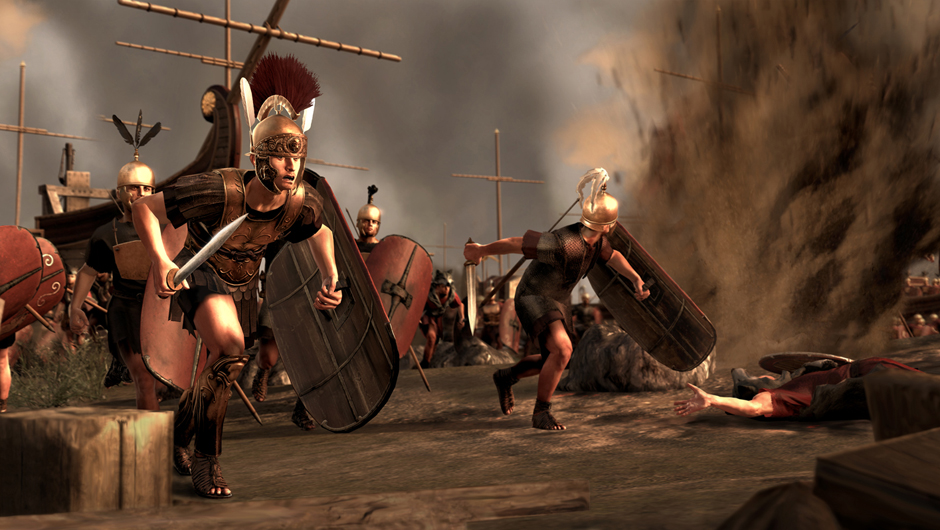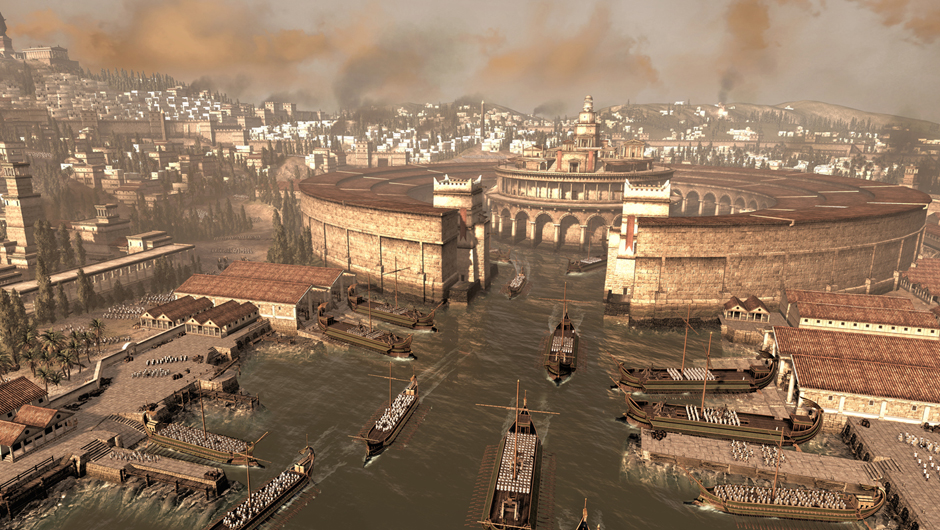Revisionist History 101.
The year was 272 B.C. Britannia’s rainy weather at the time was constant, but little did the world know that the sun would break through the clouds a few hundred years later, when the Iceni tribe would rise as rulers of the Western world! All hail our Celtic overlords!
Well, it never happened, you see, but Creative Assembly, the development team behind Total War: Rome II clearly want you to throw your textbooks away, turn off the History Channel, and focus on the “What if…?” possibilities presented to you. Frankly, that’s fine by me.
Newcomers to the series have a lot to take in here. Gameplay is divided into Campaign and Battles, where players mind the machinations of building an empire in the former and slaughter a couple thousand folks in the latter. Total War: Rome II tries to introduce new players to what’s expected of them via the Prologue, which starts with you leading the Romans in a grandiose battle to save a settlement, but once you start a new campaign, you’ll find out that there is still so much to learn.
On the Campaign map, you are given one or more settlements to control, an army or two led by a general, and a quick introduction in which your neighbors might hate you. (Think Desperate Housewives, only the housewives are factions containing armies.) From here, you’ll want to muster more troops for your army, but you need to construct certain buildings in order to gain a greater variety of soldier types. However, if you’re shooting for a certain troop type, you need to research both military and civic technologies before you can build their training grounds. But that’s the easy part!

All buildings have a positive or negative effect on public order and food availability, and if either drops too low, you’ll face a rebellion in a short amount of time. Managing these requires patience and balance. As much as you want a trebuchet to fling fire into the faces of your enemies, you need to make sure your province has buildings to offset the negative public order and resource usage those come with. And don’t forget that you need money to do any of it! The Campaign mode in Total War: Rome II becomes a deeply fascinating puzzle game in this regard, but those looking to focus on just the “War” in the title may throw their hands up in frustration.
Although I really enjoyed figuring out how to balance these kinds of statistics, the game doesn’t do a good job of explaining what all of it means or why. Public order, food, and money are immediately apparent when you click on a province, but each building and technology has an effect on economic sectors, such as gaining more wealth from agriculture or reducing costs of building industry, not to mention effects on your garrison armies. More importantly, no window reflects the total sum of your buffs and discounts. So you turn to the game’s built-in Encyclopedia to learn more, but not only does it not contain informative images, it also speaks rather generally about each of the features. Tutorial videos are also vague, but they at least show you what buttons and windows you might be looking for.

For those of you looking to war yourselves out, Total War: Rome II provides plenty of opportunities to do just that. If you are playing the campaign, choosing a general and right-clicking on a settlement or another general starts the game’s Battle mode. Based on where it was initiated, the battle will take place in a fully-rendered battlefield, rife with terrain, nearby buildings, water bodies, and even weather conditions. Before everybody flies at each other, players are given time to strategically place their troops on the battlefield depending on how battle was initiated. For example, if someone’s attacking your settlement, your troops are limited to the nearby surrounding area. You can’t place them in the forest behind your enemy.
Once the war drums have begun pounding, you can begin to dispatch at will. Troops can be grouped together for ease of commanding, and you can also send them into formations for better organization, such as putting your shielded soldier in the front. Each individual troops is enhanced by buffs earned during the campaign, and as your general levels up, they are given abilities to enhance them in real time on the battlefield. The only real enhancement I wished for, however, was better AI and pathing. There are times when troops will take the least strategic way to get to a point and others when they just appear to be sitting there no matter how frequently you tell them to do something. Battles as a whole are fun, but as they become harder, you might want to know why your archers aren’t defending themselves as your army is whittled down.

On top of the thrill of winning an unsure battle against an enemy army, you will probably also be immediately impressed by the fact that you are watching thousands of soldiers across a huge fully-rendered environment. Players can zoom into ground level to watch the action as individual soldiers defend and slice each other up. In fact, Total War: Rome II has a cinematic mode that lets you set the camera on a single troop for a while. As cool as that is, taking your eyes off managing the battle is just not recommended unless your enemy is way outnumbered. Also, up close is where you can witness soldiers running through each other like ghosts and questionable floating weapons and shields, so mind that zoom.
Let’s not forget the multiplayer component now. Friends can choose to play the campaign together. If you thought leading the Egyptians to world victory sounded silly, just imagine if their best friends were the Carthaginians. Although each faction in single player have their own goals to complete per chapter, these strange multiplayer alliances just share a goal taking over the world for dozens of hours (slumber parties not included). Each player takes a turn advancing on the map, and when battles are initiated, both can vote how they’ll play out. Either one can watch while the other spectates, or the auto-resolve function, which is also available offline, will use statistical comparisons to call victory for either opponent.

Other options include the obvious, like joining quick matches determined by the server or hosting custom battles. When hosting, not only are you able to choose general settings for battle, but you can pick anywhere on the game’s expansive map to spar. The game is set to render any point and allows you to bookmark preferred locations. If the ridiculous amount of time you can sink into the single-player campaign doesn’t keep you hooked, you can easily drop your free time entirely into these options.
Aside from minor collision detection and AI issues, Total War: Rome II is a very technically capable piece of software. Multi-thousand soldier battles run flawlessly and cleanly with no awkward hiccups. Players will be able to fly around the battlefield as quickly as needed to micro-manage, and zooming towards and away from the ground is smooth. Again, watching all the pieces go at it on hilly landscapes while rain is beating down on them is always impressive. On the Campaign map, fewer graphical resources are needed, but the map is still a treat to look at, with varying terrain and weather displays—Egypt is notably sunnier and golden (and camel-covered) than the lush green but dark Britannia.

If there’s anything that’s notably slow, it’s the amount of time it takes between turns. When a player ends a turn, every other faction, whether encountered or not, takes a turn too. Initially, this waiting time is negligible. However, as you sprawl across the map and befriend or piss off more factions, watching the wheel of factions turn up top takes longer and longer. This is also noticeable in multiplayer, where having two players doubles the amount of local known factions to resolve. If your rig is already chugging, expect wait times to increase exponentially.
Complaints aside, Total War: Rome II offers an insane amount of value for your money that is hard to ignore if you’re a fan of the genre. The campaign offers a lot of depth for those so-minded, and battles are a graphically frenzied treat. Hours fly by while you’re playing, and across the nine factions bundled with the game (more coming via DLC), the quantity of them you can spend rewriting world history can only technically be referred to as a “shit ton.” The cracks are there, though, so mind that zoom, both literally and figuratively.
-
Deep Campaign mode
-
…that’s almost too esoteric
-
Wild fully-rendered real-time battles with thousands of soldiers
-
AI has its stupid moments
-
Fun time sink
-
Easy multiplayer battle options available







